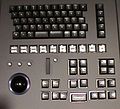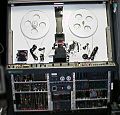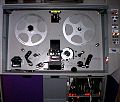- Color grading
-
Color grading or colour painting, is the process of altering and enhancing the color of a motion picture, video image, or still image either electronically, photo-chemically or digitally. The photo-chemical process is also referred to as color timing and is typically performed at a photographic laboratory. Modern color correction, whether for theatrical film, video distribution, or print is generally done digitally in a color suite. Considering such achievements in digital imaging, the artist has the ability to "paint" the image, thus the names "colorist" or "color painter" have become most applicable.
Contents
Telecine
Main article: TelecineWith the advent of television, broadcasters quickly realized the limitations of live television broadcasts and they turned to broadcasting feature films from release prints directly from a telecine. This was in the days before 1956 when Ampex introduced the first Quadruplex videotape recorder (VTR) VRX-1000. Live television shows could also be recorded to film and aired at different times in different time zones by filming a video monitor. The heart of this system was the kinescope, a device for recording a television broadcast to film.[1]
The early telecine hardware was the "film chain" for broadcasting from film and utilized a film projector connected to a video camera. As explained by Jay Holben in American Cinematographer Magazine, "The telecine didn't truly become a viable post-production tool until it was given the ability to perform color correction on a video signal."[2]
Today, telecine is synonymous with color timing as tools and technologies have advanced to make color timing (color correction) ubiquitous in a video environment.
How telecine coloring works
In a Cathode-ray tube (CRT) system, an electron beam is projected at a phosphor-coated envelope, producing a beam of light the size of a single pixel. This beam is then scanned across a film frame from left to right, capturing the "vertical" frame information. Horizontal scanning of the frame is then accomplished as the film moves past the CRT's beam. Once this photon beam passes through the film frame, it encounters a series of dichroic mirrors which separate the image into its primary red, green and blue components. From there, each individual beam is then reflected on to a photomultiplier tube (PMT), where the photons are converted into an electronic signal to be recorded to tape.
In a charge-coupled device-(CCD) telecine, a “white” light is shone through the exposed film image into a prism, which separates out the image into the three primary colors, red, green and blue. Each beam of colored light is then projected at a different CCD, one for each color. The CCD converts the light into electrical impulses which the telecine electronics modulate into a video signal which can then be color-graded for use.
Early color correction on CRT Rank Cintel MkIII telecine systems was accomplished by varying the primary gain voltages on each of the three photomultiplier tubes to vary the output of red, green and blue, respectively. Further advancements converted much of the color-processing equipment from analog to digital and then, with the next-generation telecine, the Ursa, the coloring process was completely digital in 4:2:2 color space. The Ursa Gold brought about full 4:4:4 color space.[2]
Color correction control systems started with the Rank Cintel TOPSY (Telecine Operations Programming SYstem) in 1978.[1] In 1984 Da Vinci Systems introduced their first color corrector, a computer-controlled interface that would manipulate the color voltages on the Rank Cintel MkIII systems. Since then, technology has improved to give extraordinary power to the digital colorist. Today there are many companies making color correction control interfaces including Da Vinci Systems,Pandora_International Pogle and more.
Some of the main functions of electronic (digital) color grading:[1]
- Reproduce accurately what was shot
- Compensate for variations in the material (i.e. film errors, white balance, varying lighting conditions)
- Optimize transfer for use of special effects
- Establish a desired 'look'
- Enhance and/or alter the mood of a scene — the visual equivalent to the musical accompaniment of a film; compare also film tinting.
Note that some of these functions are contrary to others. For example, color grading is often done to ensure that the recorded colors match those of the set design. In music videos however, the goal may instead be to establish a stylized look.
Traditionally, color grading was done towards technical goals. For example, in the film Marianne, grading was used so that night scenes could be filmed more cheaply in daylight. Features like secondary color correction were originally used to establish color continuity. The trend today is increasingly moving towards creative goals - improving the aesthetics of an image, establishing stylized looks, and setting the mood of a scene through color. Because of this trend, some colorists suggest the phrase "color enhancement" over "color correction".
Primary and secondary color correction
Primary color correction affects the whole image utilizing control over intensities of red, green, blue, gamma (mid tones), shadows (blacks) and highlights (whites) of the entire frame. Secondary correction is based on the same types of processing used for Chroma Keying to isolate a range of color, saturation and brightness values to bring about alterations in luminance, saturation and hue in only that range, while having a minimal or usually no effect on the remainder of the color spectrum.[1] Using digital grading, objects and color ranges within the scene can be isolated with precision and adjusted. Color tints can be manipulated and visual treatments pushed to extremes not physically possible with laboratory processing. With these advancements, the color correction process became increasingly similar to well-established digital painting techniques, and ushered forth a new era of digital cinematography.
Masks, Mattes, Power Windows
The evolution of digital color correction tools advanced to the point where the colorist could use geometric shapes (like mattes or masks in photo software such as Photoshop) to isolate color adjustments to specific areas of an image. These tools can highlight a wall in the background and color only that wall — leaving the rest of the frame alone — or color everything but that wall. Subsequent color correctors (typically software-based) have the ability to use spline-based shapes for even greater control over isolating color adjustments. Color keying is also used for isolating areas to adjust.
Inside and outside of area-based isolations, digital filtration can be applied to soften, sharpen or mimic the effects of traditional glass photographic filters in nearly infinite degrees.
Motion Tracking
When trying to isolate a color adjustment on a moving subject, the colorist traditionally would have needed to manually move the mask to follow the subject. In its most simple form, motion tracking automates this time-consuming process using algorithms to evaluate the motion of a group of pixels. These techniques are generally derived from match moving techniques used in special effects and compositing work.
Motion tracking can be combined with other techniques to add light to a subject's eyes or achieve the final look wanted for a scene. This not only saves time on the set (and money) but, when done in close collaboration with the cinematographer, allows greater flexibility in adjusting the overall feeling of the scene.
DI
Main article: Digital intermediateThe evolution of the telecine device into film scanning allowed the digital information gathered from a film negative to be of sufficient resolution to transfer back to film. In the late 1990s, the films Pleasantville and O Brother, Where Art Thou? advanced the technology to the point that the creation of a digital intermediate was possible, which greatly expanded the capabilities of the digital telecine colorist in a traditionally film-oriented world. Today, many feature films go through the DI process, while manipulation through photochemical processing is decreasing in use.
In Hollywood, O Brother, Where Art Thou? was the first film to be wholly digitally graded. The negative was scanned with a Spirit DataCine at 2K resolution, then colors were digitally fine-tuned using a Pandora MegaDef color corrector on a Virtual DataCine. The process took several weeks, and the resulting digital master was output to film again with a Kodak laser recorder to create a master internegative.
Hardware-based versus software-based systems
Hardware-based systems (da Vinci 2K, Pandora, etc.) have historically offered better performance and a smaller feature set than software-based systems (i.e. Apple's Color (previously Silicon Color Final Touch), ASSIMILATE SCRATCH, IRIDAS SpeedGrade, SGO Mistika, etc.). While hardware-based systems always offer real-time performance, software-based systems need to render as the complexity of the color grading increases. On the other hand, software-based systems tend to have more features such as spline-based windows/masks and advanced motion tracking.
The line between hardware and software is blurring as many software-based color correctors (e.g.Pablo [1], Mistika, SCRATCH [2], Autodesk Lustre, Digital Vision Film Master and Filmlight Baselight) use multi processor workstations and a GPU (graphics processing unit) as a means of hardware acceleration. As well, some newer software-based systems use specialized hardware to improve performance (e.g. da Vinci Resolve). Some color grading software like Synthetic Aperture's Color Finesse runs solely as a software based and will even run on low-end computer systems.
Hardware
"Pogle" redirects here. For other uses, see Pogle (disambiguation).The control panels are placed in a color suite for the colorist to operate.
- For high-end systems many[citation needed] telecines are controlled by a Da Vinci Systems color corrector 2k or 2k Plus, which is also called color grading.
- Other high-end systems are controlled by Pandora Int.'s Pogle, often with either a MegaDEF, Pixi, or Revolution color grading system.
- Additionally, color grading systems require an edit controller. The edit controller controls the telecine and a VTR(s) or other recording/playback devices to ensure frame accurate film frame editing. There are a number of systems which can be used for edit control. Some color grading products such as Pandora Int.'s Pogle have a built in edit controller. Otherwise, a separate device such as Da Vinci Systems' TLC edit controller would be used.
- Older systems are: Renaissance, Classic analog, Da Vinci Systems's: The Whiz (1982) and 888; The Corporate Communications's System 60XL (1982–1989) and Copernicus-Sunburst; Bosch Fernseh's FRP-60 (1983–1989); Dubner (1978-1985?), Cintel's TOPSY (1978), Amigo (1983), and ARCAS (1992) systems. All of these older systems work only with standard-definition 525 and 625 video signals, and are considered near obsolete today.
Software
The controls are shown on-screen and are sometimes accessed as plugin in a host application.
- Software like Synthetic Aperture's Color Finesse runs as a plugin in host applications like Apple's Final Cut Pro, Adobe's After Effects and Premiere.
- Magic Bullet Colorista II [3] from Red Giant Software offers multi-step color correction with primary, secondary and master stages inside host applications including Apple's Final Cut Pro, Adobe's After Effects and Premiere.
- The Grading Sweet is a package of specialized Color Grading plugins for Apple's Final Cut Pro, designed by a cinematographer.
- Sony Vegas has many filters that can provide professional quality color grading.
- Apple Final Cut Studio 2 Contains Apple Color [4] which is a dedicated software application for color grading.
- Bones Dailies by Digital Film Technology
- Other programs have their own color grading options (for example Edius, in which there is a "Color Correction" video effect - with it, you can do a "day to night*" effect (turning footage shot during the day to look like it was shot during the night).
- Autodesk Lustre is another high-end color grading solution. It features GPU acceleration for most functions.
- Mistika (SGO) is a powerful color grading suite.
- Baselight from FilmLight is often used for Stereo3D and 4K color grading because of its powerful cluster architecture.
-
SDC-2000 Spirit DataCine Film Deck
-
Rank Cintel Mark 3
See also
References
- ^ a b c d Kallenberger, Richard H., Cvjetnicanin, George D. (1994). Film into Video: A Guide to Merging the Technologies. Focal Press. ISBN 0-240-80215-2
- ^ a b Holben, Jay (May 1999). "From Film to Tape" American Cinematographer Magazine, pp. 108-122.
External links
- "From One Light To Final Grade", and other articles from finalcolor.com about color grading techniques and equipment
- Video demo of Autodesk Lustre at IBC 2006, using the example of grading "Tsotsi", the South African film from 2005.
- The Telecine Internet Group, since 1992 with associated mailinglist for colorists.
- The Art and Craft of Color Grading, blog by Dado Valentic chief colorist at Mytherapy.
Film crew Pre-production and filmmaking Film producer · Unit production manager · Production coordinator · Line producer · Film director · Assistant director · Casting director · Screenwriter · Production assistant · Script supervisor · Script coordinator · Location managerProduction design ArtSetsHair and make-upWardrobePropsSpecial effectsPhotography CameraLightingGripSound Production soundSound editingMusicPost-production EditorialLaboratoryColoristVisual effectsVideo processing Post-processing Special processing 24 to 30 fps conversion 30 to 24 fps conversion Inverse telecine
Wikimedia Foundation. 2010.











